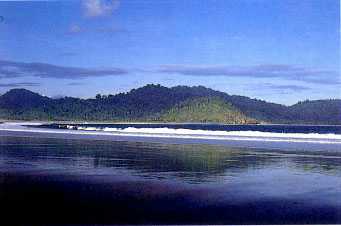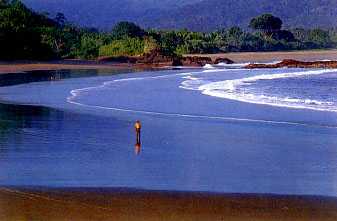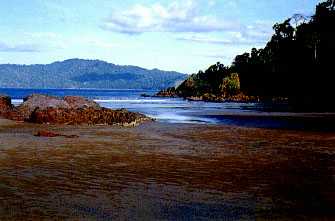
Travel Notes
 After
passing through the village of Sarongan, we entered the 1,100
hectare Sukamade Baru estate, a coffee, rubber and cocoa plantation
which was founded in 1927. Before entering Sukamade itself, however,
we stopped to visit two magnificent beaches which, as yet, are
completely undeveloped. The first, Rajegwesi, is a true paradise.
Surf rolls into a large bay surrounded by green, forest covered
hills and impressive rock formations. A fishing hamlet at one
end of the beach is the only sign of human habitation. Here,
a small guest house with food provided (by prior arrangement)
is the sole accommodation available at present. After
passing through the village of Sarongan, we entered the 1,100
hectare Sukamade Baru estate, a coffee, rubber and cocoa plantation
which was founded in 1927. Before entering Sukamade itself, however,
we stopped to visit two magnificent beaches which, as yet, are
completely undeveloped. The first, Rajegwesi, is a true paradise.
Surf rolls into a large bay surrounded by green, forest covered
hills and impressive rock formations. A fishing hamlet at one
end of the beach is the only sign of human habitation. Here,
a small guest house with food provided (by prior arrangement)
is the sole accommodation available at present.
From Rajegwesi, the road twists, turns and climbs up to the top
of some sheer cliffs from where, looking back to the east, there
is a spectacular view of Rajegwesi Bay. Looking in the other
direction, through the trees and several hundred metres below,
are two small coves, one green and one blue. The former is known
as Teluk Hijau or, appropriately, 'Green Bay'. It is necessary
to descend on foot to appreciate these small beaches to the full
and it is well worth the effort. As we made our way down the
narrow, forest covered pathway, large black monkeys (lutung)
swung in the trees overhead and we came across fresh deer tracks.
Teluk Hijau itself was strewn with small green pebbles Iying
on the white sand, perhaps partly the cause of the water's extraordinary
colour here.
It took about two more hours and a few more rivers before we
arrived finally at Sukamade. By now it was already dark and we
rested for a while before travelling the last few kilometres
to the turtle beach. As the almost full moon rose, illuminating
the spray from the enormous surf, we waited on the edge of the
sand for a turtle to come crawling out from the sea. Nothing
happened for a while and so we scattered, searching for the telltale
tracks in the semi-darkness. Then one of us came running up in
excitement. A turtle had been spotted right up at the top of
the beach, above the high water mark and almost in the trees.
We crept up on it but were unable to tell whether it was digging
the hole in which to lay the eggs or covering them over. We waited
for about half an hour, after which the turtle suddenly began
making its way back to the ocean. Clearly we had arrived too
late. Even so, we felt fortunate to have seen one of these magnificent
creatures in the wild.
Rajegwesi
 |
 |
|
